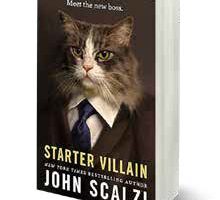We will never venture far into ìthe final frontierî until we find a way to traverse the vast distances of space. For now, only science fiction writers can zip us across the universe using whatever method their minds are capable of conjuring up. Thatís exactly what makes the genre so much fun to read. But truly good science fiction should be as thought-provoking as it is entertaining. Half cerebral, half bullet-dodging action, ìSplit Secondî by Douglas E. Richards, certainly meets both requirements.Richards opens with one of the few domestic scenes in this novel. Twenty-six year-old Jenna Morrison, a PhD candidate studying genetics, is in Chicago visiting her sister who recently had a baby. While Jenna would love to stay longer, sheís anxious to get back to her course work, and her fiancÈ, Nathan Wexler. When she arrives home in La Jolla, Nathan, ìa brilliant physicist and mathematician,î is acting like ìthe cat that swallowed the canary.î He believes he has made a discovery ìworthy of a Nobel Prize.î But before breaking out the champagne, he wants to triple check his findings with his friend and fellow physicist, UCLA professor Dan Walsh.Nathanís discovery is based on an obscure mathematical equation that up until now appeared to serve no purpose. However, he thinks it holds the key to traveling back in time, even if only for a ìSplit Second.î While that hardly seems relevant in the quest to reach other planets, never fear, the author comes up with an intriguing function for this seemingly useless equation.Unfortunately, Jenna never learns the details of the breakthrough because she and Nathan are abducted from their home that very evening. Their kidnappers claim they will not be harmed, so long as they do not try to escape. Placed in the back of a Hostess Cake delivery truck, the couple is accompanied by what appears to be government agents. Their journey is interrupted 90 minutes later, when the driver of the semi encounters a roadblock. Suddenly, ìa small stretch of Palomar Mountain State Park becomes a war zone.î In the ensuing battle, Nathan meets an untimely death. Or does he? This is science-fiction after all, which means just about anything is possible.Jenna barely escapes, only to encounter more special-ops men who seem to think she holds the key to Nathanís discovery. Now alone, she must get answers to a number of questions. Who kidnapped them, who attacked the truck, and why are both groups now hell bent on capturing her? Seeking help and protection, she stumbles onto Aaron Blake, ìan ex-army Rangerî turned private investigator. As the two set about trying to unravel these mysteries, their progress is thwarted by a hail of bullets, hovering helicopters and tranquilizing grenades.Eventually, the opposing teams come into focus. It would be a ìspoilerî to reveal the organizations or the names of the leaders. But I will divulge two of the settings where much of the scientific tinkering takes place. One is a futuristic base at Lake Las Vegas, a 320-acre artificial lake in Henderson, Nevada. It houses some of the most brilliant scientists money can buy. The second base makes the book even more entertaining for local readers because it is split between two sites in El Paso County.You may be flummoxed when attempting to discern the ìgood guysî from the ìbad guys.î Itís little wonder, since each group appears to have an unlimited supply of former special-ops agents, with a few traitors thrown into the mix just to keep you on your toes.During a lull in the action, Jenna and Blake consult with Dan Walsh, who gives us a brief explanation of time. For all practical purposes, most of us think we exist for a narrow band of years, with our future yet to come, and our past dead and gone. ìNewton thought time was an absolute,î Walsh explains. Meaning it flowed in the same past, present and future that we perceive in everyday life. Then came Einstein; he said, ìSpace and time could not be separated.î Under his ìspace-time continuumî theory, the past, present and future are one and the same, with time indeed being ìalready laid out in its entirety.î We mere mortals just have difficulty viewing it that way.Walsh then dives into a discussion of ìretrocausalityî that turns cause and effect on its head, wherein the future can indeed impact the past. Next, we are introduced to Richard Feynmanís diagrams; his theory of how antimatter can travel backward in time. Most of us are familiar with Feynman because of his role in determining why the space shuttle Challenger exploded. But his true contribution to science was a body of work that ìrevolutionized nearly every aspect of theoretical physics.îFor me, all this musing about the exact nature of time is the best part of ìSplit Second,î especially when accompanied by a good glass of wine. While this heady subject is certainly worthy of academic study, the author makes it easier for a lay person to digest, by intertwining science with action-packed fiction.Although Richardsí character development is somewhat thin, I believe his plot, settings and manipulation of Feynmanís theories more than make up for that. Be sure to read the notes he provides at the back of novel; he certainly did his research! Then he put his own spin on science, and in a ìSplit Secondî he created a science fiction novel that takes your mind on a most enjoyable journey.







